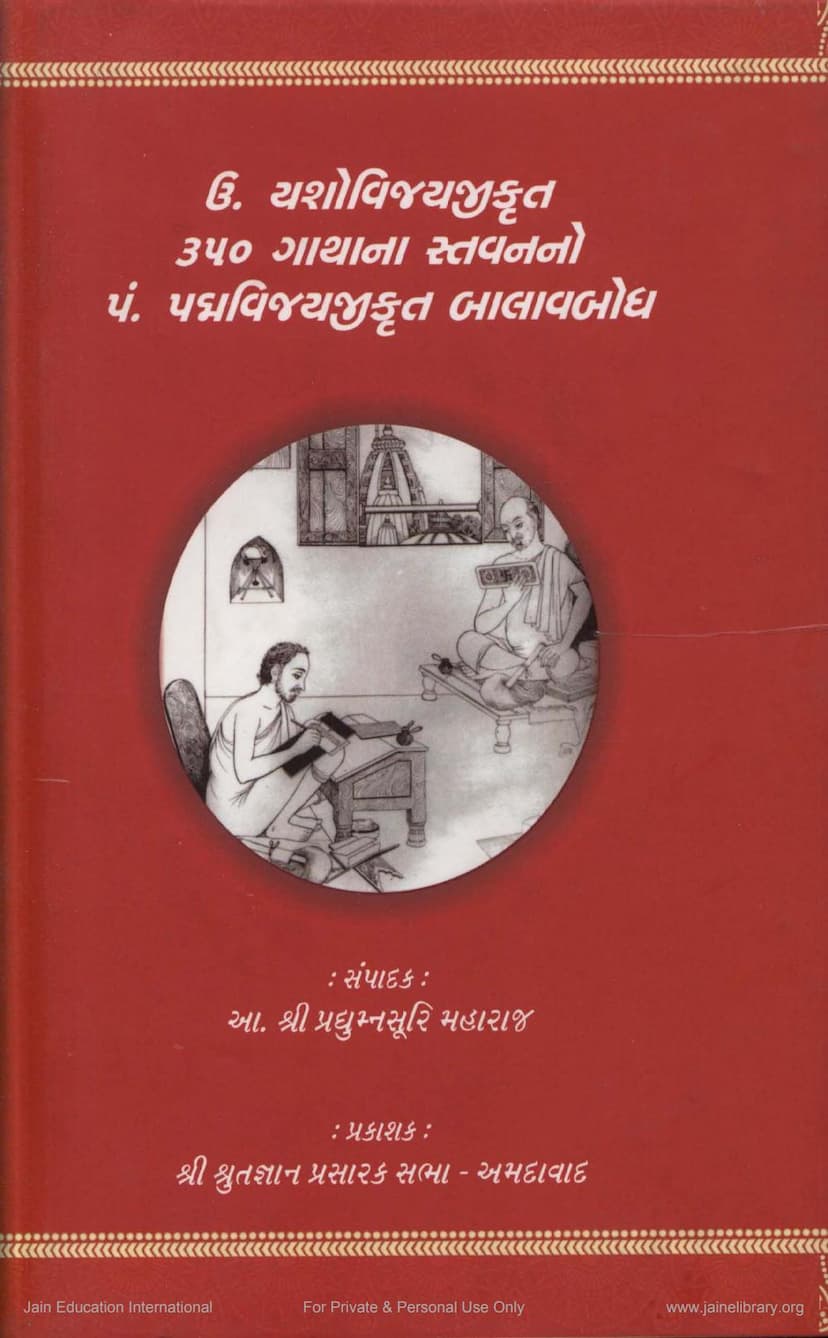Yashovijayji Krut 350 Gathana Stavano Padmavijayji Krut Balavbodh
Added to library: September 2, 2025

Summary
Here's a comprehensive summary of the Jain text, "Yashovijayji Krut 350 Gathana Stavano Padmavijayji Krut Balavbodh," based on the provided pages:
Title: YashovijSji Krut 350 Gathana Stavano Padmavijayji Krut Balavbodh Author/Editor: Edited by Acharyashri Pradyumnasuri Maharaj Publisher: Shri Shrutgyan Prasarak Sabha, Ahmedabad Catalog Link: https://jainqq.org/explore/004563/1
Overview:
This book is a Gujarati commentary (Balavbodh or Tika) by Pandit Padmavijayji Maharaj on the 350-stanza Stavan composed by Upadhyay Yashovijayji Maharaj. The Stavan itself is a significant devotional and philosophical work within Jainism, and Padmavijayji's commentary aims to make its profound teachings accessible to a wider audience, particularly the common Jain community. The book is presented as a valuable resource for spiritual seekers to understand and follow the path prescribed by Lord Mahavir.
Key Themes and Content:
The text is structured around the 350 stanzas (gathas) of Yashovijayji's Stavan, each stanza being elucidated by Padmavijayji's Balavbodh. The commentary delves into a wide array of Jain philosophical concepts, ethical principles, and practical guidance for spiritual progress. Key themes include:
- The Importance of Right Faith and Conduct: The text repeatedly emphasizes the necessity of following the true Jain path, rooted in the teachings of the Tirthankaras, as explained through the lens of syadvada (manifold perspectives).
- Critique of Ignorance and Deviations: Padmavijayji's commentary highlights and critiques various misconceptions and deviations from the true path that had crept into the Jain community. This includes:
- Blind adherence to tradition vs. true understanding: The importance of understanding the essence rather than just the ritualistic aspect of practices.
- The fallacy of mere outward appearances: Criticizing those who maintain the outward symbols of Jainism without inner spiritual substance or genuine adherence to principles.
- Misinterpretation of scriptures and practices: Explaining how scriptures are to be understood in context and how literal interpretations can lead to erroneous conclusions.
- The dangers of individualistic interpretations and self-reliance: Emphasizing the need for guidance from learned preceptors (gurus) and adherence to the established tradition.
- The Role of the Guru and Tradition: The commentary underscores the indispensable role of a qualified guru and the importance of following the lineage and established practices of the Tirthankaras and their disciples. The critique of deviations often comes from the perspective of preserving the purity of the tradition.
- Distinction between True and False Practices: The text meticulously distinguishes between genuine spiritual practices and those that are merely outward show or based on ignorance. This involves explaining the correct understanding of vows (vratas), conduct (achara), knowledge (jnana), and faith (samyaktva).
- The Nature of the Soul and Reality: The commentary touches upon the Jain understanding of the soul (Jiva) and non-soul (Ajiva), the interplay of permanence and change, and the path to liberation (moksha).
- The Syadvada Perspective: The text, following Yashovijayji, champions the syadvada approach, advocating for a balanced understanding that considers multiple perspectives without falling into absolutism or nihilism.
- Ethical and Moral Guidance: Padmavijayji's commentary provides detailed explanations of virtues and vices, offering practical advice on how to cultivate positive qualities and overcome negative ones. This includes discussions on:
- The nature of desire and detachment: Understanding the subtle ways attachment can hinder spiritual progress.
- The role of knowledge in action: Emphasizing that actions must be guided by right knowledge.
- The dangers of ego and self-pride: Critiquing those who believe they have reached a high spiritual state prematurely or due to mere outward austerity.
- The importance of humility and adherence to discipline: Highlighting that genuine spiritual progress is marked by humility and disciplined conduct.
- Scholarly Rigor and Diligence: Padmavijayji's commentary is noted for its scholarly depth, referencing numerous other Jain scriptures (agamas, niyuktis, vruttis, etc.) and providing detailed explanations of complex philosophical points. The editor, Pradyumnasuri, highlights Padmavijayji's meticulous approach, even noting when he deviates from or clarifies earlier commentaries to ensure accuracy and deeper understanding.
- The Structure of the Stavan: The book is organized into 17 "Dhals" (chapters or sections), each covering a specific set of stanzas from the original 350-stanza Stavan. The "Balavbodh" provides a verse-by-verse or stanza-by-stanza explanation.
Significance and Purpose:
The publication of this commentary by Shri Shrutgyan Prasarak Sabha, Ahmedabad, reflects a commitment to propagating Jain knowledge. The Balavbodh serves as a vital tool for:
- Deepening Understanding: Making the profound spiritual insights of Upadhyay Yashovijayji accessible to students and scholars of Jainism.
- Spiritual Guidance: Providing practical steps and ethical frameworks for the spiritual journey of lay followers (Shravakas and Shravikas) and ascetics (monks and nuns).
- Preserving Tradition: Upholding and explaining the nuances of Jain philosophy and practice against the backdrop of contemporary deviations.
- Promoting Study: Encouraging the regular study, contemplation, and practice of the Stavan and its teachings.
Contribution of the Editor and Supporters:
The editor, Acharyashri Pradyumnasuri Maharaj, is acknowledged for his diligent work in compiling and editing the text. Special mention is made of the encouragement and guidance provided by Upadhyay Shri Bhuvanchandji Maharaj, who reviewed the entire work and offered valuable suggestions. Professor Kantibhai B. Shah is also recognized for his significant effort in completing the task. The preface also thanks Shri Shrenik from Kirit Graphics for their work in printing.
Overall Message:
The book underscores the profound wisdom of Upadhyay Yashovijayji and the illuminating commentary of Padmavijayji, presented with the aim of guiding the Jain Sangh towards spiritual upliftment. It emphasizes that true spiritual progress comes from following the divine commands (Agnas) of the Tirthankaras, which are reflected in the scriptures and lived by true spiritual masters. The text is a call to uphold the purity of the Jain tradition and to engage in sincere spiritual practice guided by wisdom and humility.